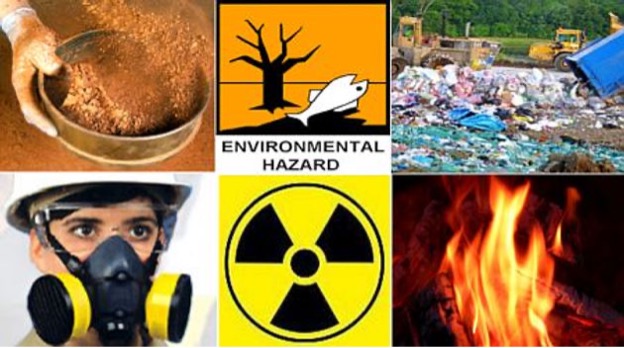Module 6: Environmental Hazards and Toxicology
Section outline
-

A wide range of environmental hazards we come across in almost all habitats and public and private properties including, but not limited to, the work place, construction areas, parks and recreational areas, industries, and living beings. All living beings experience them directly or indirectly in their habitats – local, state, regional, national, and international. Environmental hazards can also be classified into three interrelated categories (biological, chemical, and physical) based on the properties of their causes and interactive behavior. For example, indoor air pollution is both a traditional and chemical hazard; a flood and global warming are primarily physical hazards, but they can lead to the spread of waterborne disease (a biological hazard), increased levels of greenhouse gases such as carbon dioxide, methane, etc., (chemical hazards); infectious diseases (biological hazards) can also weaken the immune system, making an individual more vulnerable to chemical hazards. The diverse kinds of interactive environmental stressors and their hazards are narrated below.
Toxicology deals with a variety of chemical hazards that operate over longer periods of time (rather than as events), and they include climatic factors and many kinds of chemical and thermal pollution. Depending on the intensity of exposure, organisms may suffer acute toxicity resulting in tissue damage or even death, or a less-obvious chronic damage that results in decreased productivity (source: B. Freedman). For instance, excessive levels of sulfur dioxide emit from the industries into the atmosphere will reduce the productivity of vegetation and its quality or even loss of vegetation.
Upon completion of this module, you will be able to:- Describe the various types of environmental hazards.
- Explain the causes of hazards and how biota respond to changes in ecosystems.
- Differentiate natural and anthropogenic hazards with examples.
- Explain the differences among various types of environmental hazards.
- Explain the most common natural and man-made hazards in the state of Louisiana.
To achieve these objectives:
- Read the Module 6 Introduction
- Read Chapter 6 in Pressbooks.
- Complete the Chapter 6 Focused Reading Quiz.
- Complete the assignment and discussion questions.
-
Guidelines for how to import content into Moodle
-
Forum Instructions
In a post below, respond to the following prompt, which assess(es) course outcome(s) X and module learning objective(s) X [linked to outcomes/objectives chapter in syllabus]. Then, you must respond to (X) of your classmates' posts. After you post a response, you will be able to see other responses. You are not required to post more than once, but feel free to respond to other posts and engage with your classmates[Edit previous three sentences to suit forum function/requirements].
Your [first] post is due on [day of week] by [time] CST. Your response to another student is due on [day of week] by [time] CST. [Adjust for number of posts required.]
Your response should be at least [length requirement in words, sentences, or paragraphs] long. This includes responses to other students' posts. [Include previous sentence if necessary.] A simple “I agree” or “Yes” or “LOL” will not count. Please think about the questions and your peers' responses and reply thoughtfully and courteously, according to netiquette rules. Use good English grammar, correct punctuation, and complete sentences. While the posts will mostly be judged by their thoughtfulness and completeness, I reserve the right to take off points for grammatical errors, especially if they interfere with the clarity of the post. [Edit as needed.]
Prompt
Watch the YouTube video ( ) completely and discuss the role of water quality, lead (Pb), bacteria, and humans in Flint, Michigan, hazardous situation. (Points: 20; Word limit for your own response: 100 – 125; Word limit for your critique on one of your peer’s response: 50-70; Please do manual spell check before submission on Canvas). Discussion will be graded following the rubric.
Details:
A forum for discussion promotes peer-to-peer and student-instructor interaction. Questions should be thought provoking and encourage detailed analysis of module topics. Include a rubric.
If you do not want students to see other responses before they post, set type to "Q and A forum." For this type, you must create a post first for students to respond.
Subscription: Set to Auto.
Due dates: You cannot set due dates for forums, so be sure to tell students when to post above. These dates will not appear on the Moodle calendar.
Ratings: will place the forum in the gradebook. You can set a maximum grade. Restricting ratings to a date range only affects when you can grade, and not when the activity is available to students.
Activity completion: You can select completion criteria and an expected completed date.
Background Colour
Font Face
Font Kerning
Font Size
Image Visibility
Letter Spacing
Line Height
Link Highlight
Text Colour
